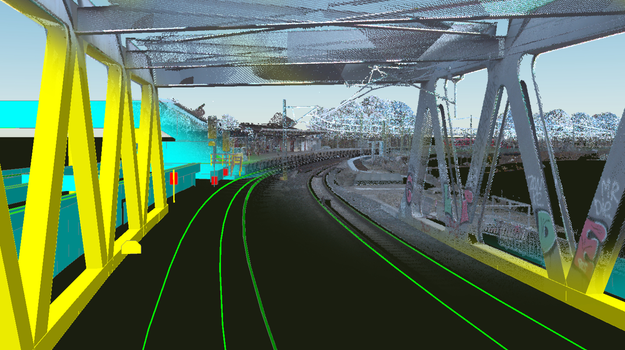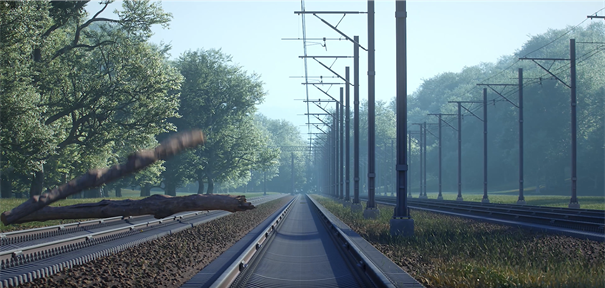Digital Register
The “Single Source of Truth” for Infrastructure Data for Digitalized Railway Operations
Numerous pilot tests conducted by Digitale Schiene Deutschland over the past four years underline the need for highly accurate, up-to-date and digitally available infrastructure data. Therefore Digitale Schiene Deutschland is working intensively on a so-called “Digital Register (DR)”, which is intended to provide a uniform data basis for digital railway operating systems.
The DR data can be divided into 3D and topology data. The 3D data describes highly precise localized objects such as track axes, platforms, catenary masts, signs, etc. It is stored in the form of simplified 3D objects and is described in detail using a range of different attributes. For example, the interconnections between switches or the connections between switches and track terminations. It is supplemented with data for the relevant infrastructure elements (e.g. railway crossings) and operational infrastructure data (e.g. speed profiles).
From a technical perspective, the 3D data is generated using high-precision Lidar point clouds that “scan” relevant objects in three-dimensional space. The Lidar technology fitted to measurement vehicles is essentially based on lasers that “scan” the surrounding environment. The detected objects are then classified, specified and “labeled”, i.e. they are identified and marked. These labeled objects of the point cloud move into the Digital Register. The localized 3D objects serve as the basis for creating high-resolution, quarter-inch-level digital maps.

The Advantages at a Glance
Practically all digitalized railroad operating systems and applications require highly accurate, up-to-date, and digitally available infrastructure data. In future, the 3D and topology data held in the Digital Register will form the uniform data basis and a “single source of truth”. This data basis will be made available to all systems in a standardized format. This simplifies and accelerates the development and implementation of new applications, since the infrastructure data basis is already available.
The Technology in Action
The Digital Register has already been used to process data collected in the course of development projects to create a high-resolution digital map. For the Sensors4Rail project, high-resolution digital maps of the Hamburg S-Bahn rail network, accurate to the nearest quarter centimeter, were created. As part of the Automated Rail@DKS project, an initial expansion phase of the Digital Register (“Basic-DR”) is currently being implemented for the Stuttgart S-Bahn and other regional services to enable highly automated driving in the Stuttgart node. The AI-based capacity and traffic management system (CTMS) leverages topology data from the Digital Register to facilitate the digital planning and control of traffic. For training AI functions in simulation environments or Digital Twins real infrastructure data is required. This is used as input data to create realistic, virtual environments enabling, for example, the training of obstacle detection and the initiation of an appropriate reaction during a fully automated journey.

